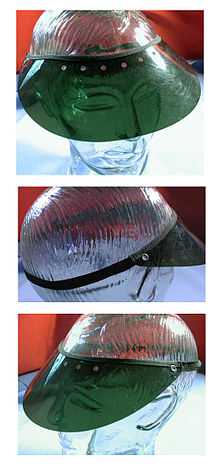Green eyeshade

Green eyeshades are a type of visor that were worn most often from the late 19th century to the middle 20th century by accountants, telegraphers, copy editors and others engaged in vision-intensive, detail-oriented occupations to lessen eyestrain due to early incandescent lights, which tended to be harsh (the classic banker's lamp had a green shade for similar reasons). Because they were often worn by people involved in accounting, auditing, economics, and budgeting, they became associated with these activities. The phrase "green eye-shades" can be applied derogatorily to individuals who are excessively concerned with financial matters or small and insignificant details.
Green eyeshades were often made of a transparent dark green or blue-green colored celluloid, although leather and paper were used to make the visor portion as well. One manufacturer, The Featherweight Eyeshade Company, described their eyeshade as "restful" to the eyes. Eyeshades were sold through office supply stores through the 1950s.
Several individuals, including one William Mahoney, received patents for their eyeshade designs. Author Carl Sandburg wore a green eyeshade, which is on display at his former residence of Connemara at Flat Rock, North Carolina. The Society of Professional Journalists annually recognizes deserving journalists working in the Southern United States with its Green Eyeshade Excellence in Journalism Award.[1] Green eyeshades are still on the market, typically sold as "dealer's visors." They retain a certain degree of popularity in the gambling community.
The gonzo journalist Hunter S. Thompson popularized the headgear for a new generation of readers. His green eyeshade was common alongside his cigarette holder, amber sunglasses, Hawaiian shirts, and Bermuda shorts and may be seen in the films Where the Buffalo Roam and Fear and Loathing in Las Vegas.
See also
References
| Wikimedia Commons has media related to Green eyeshades. |